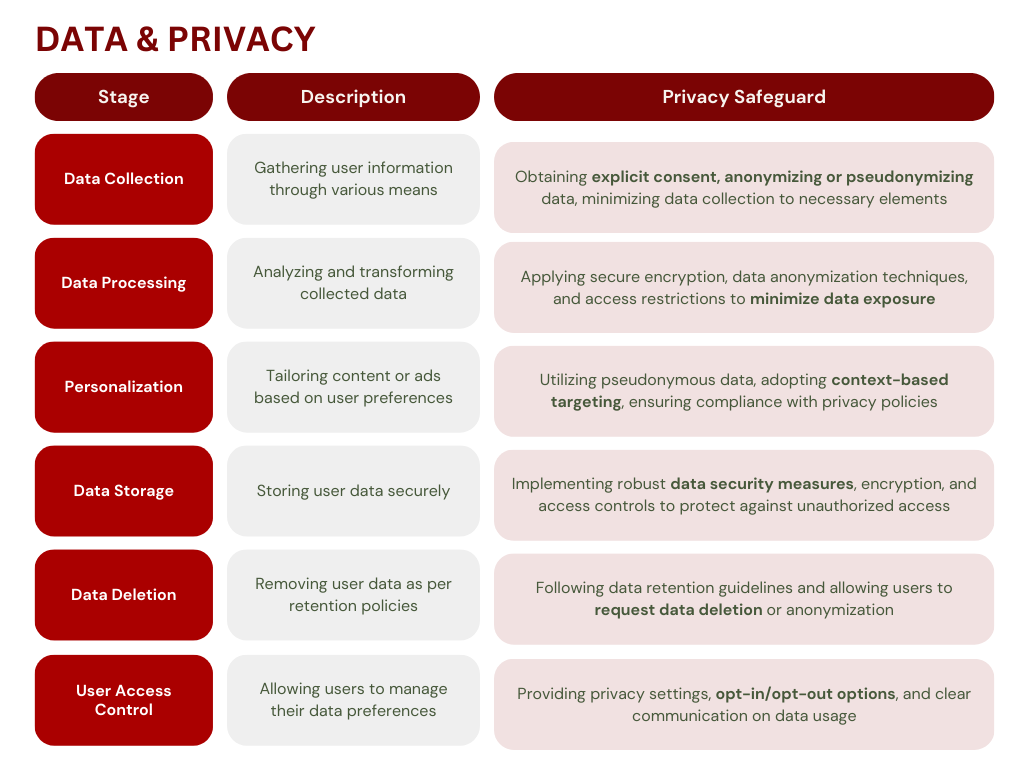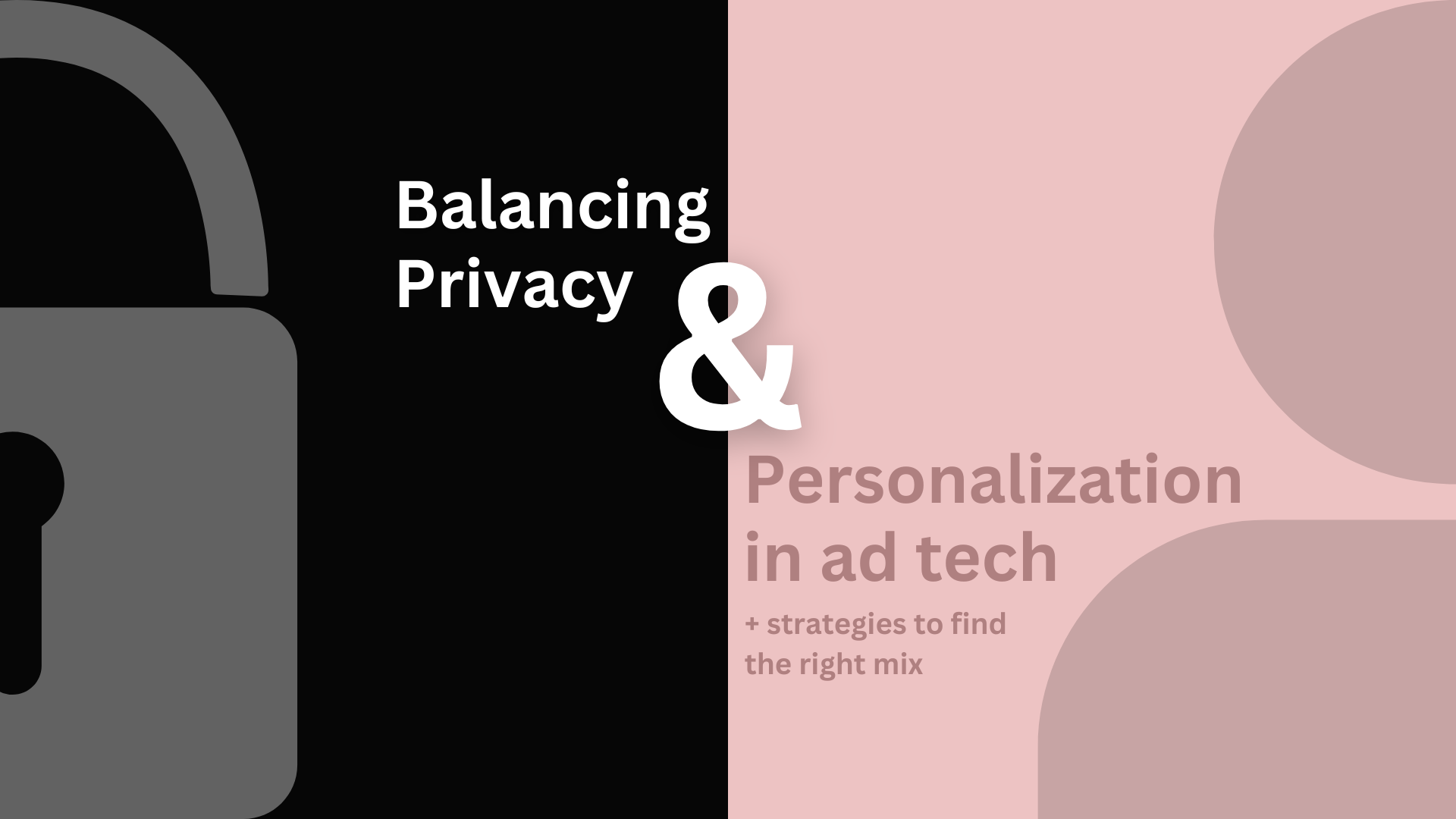Picture this:
Michael, a hopeless romantic, is determined to woo Julie and win her heart. After one date together, Michael gets to know a hint about Julie and is left awestruck. He is resolved to win her over. In his zealousness to impress Julie, Michael decides to hire someone to secretly observe her interactions, attentively listen to her conversations, and seek insights from her close friends. He believes that this information will help him create experiences that resonate with Julie on a personal level and strengthen their connection.
Initially, Julie enjoys the personalized gestures from Michael. However, over time, she starts to feel uneasy and realizes that her every move is being monitored and tracked, and her personal information is being exploited. Feeling hurt and betrayed, Julie decides to cut ties with Michael and urges him to never violate anyone’s privacy again.
Contents
The Privacy Paradox
This is the current state of the ad tech industry – Michael represents advertisers whereas Julie represents the average consumer. Users find themselves torn between the desire for personalization and the need to safeguard their privacy. On one hand, they crave tailored experiences that resonate with their interests and preferences. In fact, 71% of consumers expect a personalized experience.
On the other hand, the varying levels of anonymity that users wish to maintain add another layer of complexity. Some users willingly consent to sharing certain amounts of data, while others withhold consent altogether. Therein lies the essence of the privacy paradox. To reach today’s users, advertisers must address these divergent preferences and adopt privacy-friendly alternatives that deliver on personalization without infringing on privacy.
Personalization in Advertising
But why do brands go above and beyond to personalize their ads? Now, imagine a world where users are bombarded with countless advertisements, each vying for their attention in an overcrowded digital space. With ads flooding their screens, emails, and social media feeds, how can a brand truly make an impact? The answer lies in personalization.
Personalization is a key practice in digital marketing that involves crafting tailored content and experiences for specific individuals based on their characteristics, behaviors, and preferences. Marketers often employ this tactic to improve customer engagement, drive conversions, and build brand loyalty. 91% of consumers are more incentivized to interact with a brand that personalized its communication to them. Without personalization, many ads remain bland and ineffective
Ad-Tech: Powering Personalized Ads
Advertisers leverage ad tech to craft personalized experiences for their audiences. Ad Tech is a term encompassing the myriad of tools and technologies used by advertisers to target and deliver digital ads to their audiences based on first-party (owned) as well as third-party (external) data. Some of the tools used in the process include supply-side platforms, demand-side platforms, data management platforms, and ad exchanges.
But ad tech is a double-edged sword; it relies on vast amounts of data, much of which can be sensitive and highly personal. In the wrong hands, this data can be misused and cause harm, leading to serious consequences. Even when used ethically, the sheer amount of data about the user that is available on the internet raises concerns. There is also a looming threat of data breaches.
The Awakening: A Shift in User Mindset
Understanding the privacy paradox requires acknowledging the shifting mindset of today’s internet users. With decreasing attention spans, users have become highly selective about the content they consume, including advertisements (which they tend to ignore consciously/subconsciously). Additionally, there is a clear aversion to sharing personal information. People are increasingly aware of data being collected without their consent, or data being shared with or sold to third parties without their knowledge. This has shaped a generation of privacy-conscious digital natives who prioritize safeguarding their personal identity and data integrity. Above all, they have grown more skeptical about sharing their data.
A survey conducted by McKinsey further emphasizes the significance of privacy concerns, with 87% of respondents stating they would avoid buying from companies that raise security worries. This underscores the fact that individuals are willing to sever connections with brands if their privacy is jeopardized. Advertisers must recognize that disregarding user privacy can lead to alienating their own customer base.
Striking A Balance Between Privacy & Personalization
In light of this evolving landscape, advertisers and publishers face the challenging task of recalibrating the privacy and personalization scale to strike the right balance. MAGNA’s study showed that 82% of respondents express concern over how their data is being collected and utilized. Today’s consumers intend to reclaim their position as the rightful owners of their data by understanding how customer data is collected, used, and protected. For businesses, it’s sink or swim. Brands must prioritize transparency and provide customers with control over their data if they intend to alleviate these concerns.
Regulatory Measures to Protect User Privacy Online
This has already become mandatory by law in some places. The growing cautiousness expressed by users has exerted significant pressure on regulatory authorities to enact policies that protect user privacy. Policies like the General Data Protection Regulation (GDPR), California Consumer Privacy Act (CCPA), and Children’s Online Privacy Protection Act (COPPA) exert added pressure on advertisers to reevaluate their data collection, storage, and usage practices.
The situation has been further exacerbated by the decision of major browsers to disallow third-party cookies, which was once the primary way of tracking user activity online. This has pushed businesses to not only implement stronger safeguards for their data but also to think creatively and develop innovative ways to deliver personalized experiences while still prioritizing user privacy in a sustainable, future-proof manner.
Becoming Future Ready: Privacy-Friendly Strategies

While brands may feel like they are at the short end of the stick, there are in fact many privacy-friendly strategies that brands can employ to create meaningful and impactful conversations with their audiences.
Contextual Advertising
Instead of relying on personal data, contextual advertising involves targeting ads based on the content and context of the platform or webpage where they appear. By aligning ads with relevant content, advertisers can deliver meaningful messages without compromising individual privacy in a user-friendly way.
Example: A travel website could display ads for local attractions and hotels when users are browsing articles about vacation destinations. Leveraging the context of the content enables advertisers to deliver relevant ads without relying on personal data.
Advertising By Groups
Rather than targeting individuals, advertisers can focus on reaching groups or segments of users who share common interests or characteristics. This approach allows for effective targeting while minimizing the need for extensive data collection on individual users.
Example: A Korean makeup brand can promote its latest product line to its target audience by focusing on groups or segments of users who have shown an interest in Korean beauty trends. They can leverage Over-The-Top (OTT) platforms, such as streaming services or connected TV (CTV), that cater to a specific demographic interested in beauty and skincare.
Authentic Storytelling
Engaging users through authentic storytelling helps advertisers create impactful ads that resonate with the audience. By crafting genuine narratives and emphasizing the values and aspirations that connect with users, advertisers can establish meaningful connections without intruding on their privacy.
Example: A sustainable fashion brand could create ads that highlight its commitment to ethical sourcing and eco-friendly manufacturing. Authentically conveying its values and mission empowers the brand to establish a connection with environmentally conscious consumers without compromising their privacy.
Encourage Active Participation
Opt-in consent is a powerful strategy that encourages active participation from users, allowing them to willingly choose to receive personalized experiences and content from brands. By offering mailing lists and loyalty programs, brands can create a two-way communication channel. This gives users the option to be part of a more tailored and engaging relationship.
Example: A fitness app encourages users to join their mailing lists for personalized workout routines and nutrition tips. Opting in allows users to receive weekly emails with tailored workout plans based on their fitness goals and dietary preferences. This active participation enables users to take control of their fitness journey while receiving valuable guidance from the app.
Compliance with Regulations and Audits
Advertisers must comply with privacy regulations and undergo periodic audits to ensure adherence to data protection standards. Following regulations such as GDPR, CCPA, and others allow advertisers to show their commitment to protecting user privacy and maintaining data security.

Example: An advertising agency may undergo regular privacy audits to ensure compliance with data protection regulations. Through these audits, the agency can proactively identify and address any potential privacy vulnerabilities. This assures clients and users that their data is handled per privacy regulations and builds trust within the advertising ecosystem.
Conclusion:
In conclusion, the privacy paradox in ad tech necessitates a careful and balanced approach from the advertiser. To meet the growing demands of privacy-conscious users, advertisers must embrace privacy-centric practices while delivering personalized experiences. By switching to and adopting privacy-friendly strategies such as contextual advertising, group targeting, authentic storytelling, active participation, and regulatory compliance, advertisers can navigate this complex landscape and forge meaningful connections, foster trust, and thrive in the ever-changing ad tech ecosystem. Here’s to a sustainable and successful future for ad tech.
For Related Articles Read:
How to Overcome Banner Blindness
All You Need to Know About Contextual Advertising on Premium Publishers




